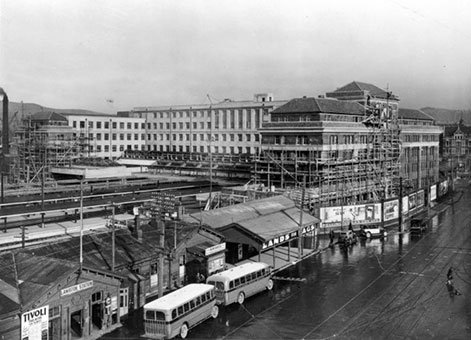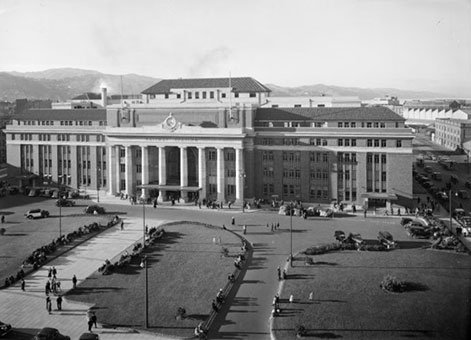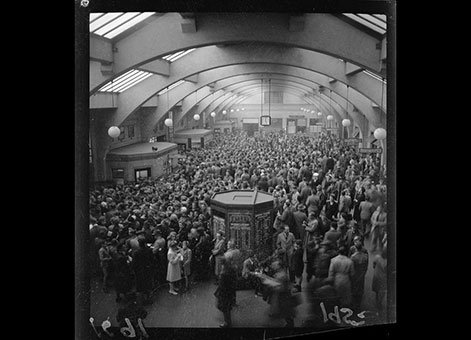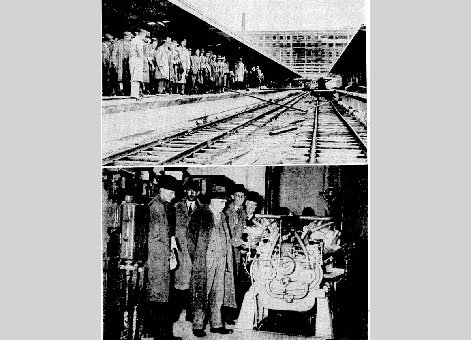When opened in 1937, this railway station was New Zealand’s largest building and one of the first seismic proofed structures in the country.

Old and new railway stations, Wellington [circa 1935]. Original photographic prints and postcards from file print collection, Box 15. Ref: PAColl-7081-11. Alexander Turnbull Library, Wellington, New Zealand.
The building covers 0.6 hectares and the original floor area was two hectares, comprising 250 rooms and 1.2 kilometres of corridors. Two storeys were added to the northern end of the Featherston Street wing during World War Two.
The station was built to accommodate 675 railways department head office and district staff, and also to replace Wellington’s two former stations, Lambton and Thorndon. All of Wellington city's early railway stations have been removed.

Gray Young, Morton & Young (Firm). Gray Young, Morton & Young (Architects): Wellington Railway Station [circa 1937]. New Zealand Free Lance : Photographic prints and negatives. Ref: 1/2-101158-G. Alexander Turnbull Library, Wellington, New Zealand.
The new railway station was built on reclaimed land and was designed in accordance with studies of seismic effects on contemporary buildings in Japan. The steel frame is encased in reinforced concrete and supported on groups of reinforced concrete piles. Bricks used for the outer cladding are of a special design with slots to accommodate vertical rods which reinforce the brickwork and bind it to the structural members. The building required 1.75 million bricks, plus 1,500 tonnes of decorative stone (granite and marble).

Crowd at Wellington Railway Station [1950]. Negatives of the Evening Post newspaper. Ref: 114/210/22-F. Alexander Turnbull Library, Wellington, New Zealand.
Wellington Railway Station has worn well. It still copes with daily passenger loads with very little alteration having proved necessary. In its first year, 7,600 passengers made 15,200 trips on 140 trains daily. In 2014 there were nearly 12 million passenger trips on Wellington region trains.
As well as an impressive functional record, the building is a dignified and largely undated structure, with impressive architecture.

Members of the conference of the New Zealand Society of Civil Engineers yesterday paid a visit to the new Wellington Railway Station (Evening Post, 21 February 1936). Alexander Turnbull Library, Wellington, New Zealand.
Heritage recognition
IPENZ Engineering to 1990 project
This item of New Zealand’s engineering heritage was recognised as part of the IPENZ “Engineering to 1990” project, which the Institution organised to help celebrate the country’s sesquicentenary in 1990. A plaque was unveiled to mark the significance of this railway station as part of the development of the nation.
This place has been recognised by Heritage New Zealand as a Category 1 historic place (List no.1452)
Wellington Railway Station: New Zealand Heritage List/Rarangi Korero information.
This place is on the Rail Heritage Trust of New Zealand's Register/National Rail Heritage Collection as a Category A building.
More information
Access
The railway station is open to the public. Access to office areas is restricted.
Additional image gallery details
Old and new railway stations, Wellington [circa 1935]. Original photographic prints and postcards from file print collection, Box 15. Ref: PAColl-7081-11. Alexander Turnbull Library, Wellington, New Zealand.
Gray Young, Morton & Young (Firm). Gray Young, Morton & Young (Architects): Wellington Railway Station [circa 1937]. New Zealand Free Lance : Photographic prints and negatives. Ref: 1/2-101158-G. Alexander Turnbull Library, Wellington, New Zealand.
Crowd at Wellington Railway Station [1950]. Negatives of the Evening Post newspaper. Ref: 114/210/22-F. Alexander Turnbull Library, Wellington, New Zealand.
Evening Post Photos. VISIT TO STATlON—Members of the conference of the New Zealand Society of Civil Engineers yesterday paid a visit to the new Wellington Railway Station. At top some of the visitors are shown inspecting new platforms. Below, visiting the main substation which supplies power to the railway station and yards (Evening Post, 21 February 1936). Alexander Turnbull Library, Wellington, New Zealand.
Permission of the Alexander Turnbull Library, Wellington, New Zealand, must be obtained before any re-use of these images.
Location
Bunny Street, Wellington.
